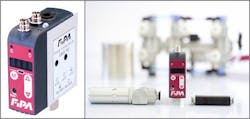FIPA Announces Extremely Efficient, Air- & Energy-Saving EMA Series Compact Ejector
FIPA Inc., a leading manufacturer of advanced vacuum technology, gripper systems, air nippers, tube lifters, and End-of-Arm-Tooling (EOAT), announces its extremely efficient, air- and energy-saving EMA Series compact ejector. Ideal for use in pick-and-place packaging technology, as well as in various applications throughout the plastics, automotive, packaging, and sheet metal forming industries, EMA Series compact ejectors combine a pressure regulating, energy-saving function with an electronic air-saving function to achieve operational savings of up to 97% when handling non-porous, light- to medium-weight workpieces. The series also combines electronic vacuum and blow-off control functions in a single signal to achieve extremely short cycle times, and features an integrated open silencer for noise reduction, and a compact, IP65 dust-resistant block construction that both negates the need for additional filtration and enables space-saving assemblies.
“Our EMA Series compact ejectors are rugged, reliable, flexible, and exceedingly economical, enabling significantly faster cycle times and lower operating costs in material handling applications across the plastics, automotive, packaging, and sheet metal industries, regardless of material, weight, or porosity,” said Rainer Mehrer, president of FIPA. “As such, EMA Series ejectors frequently amortize within a few short months.”
EMA Series ejectors were thoughtfully designed to provide maximum energy savings without limiting the overall performance of production systems. They operate by supplying a Venturi nozzle with compressed air to generate a vacuum, which allows an attached suction cup to quickly grip the workpiece. A vacuum switch continually monitors the vacuum level to control air savings, and triggers the “item gripped” signal at the first vacuum threshold limit (V1, 65%), allowing the scheduled operation (e.g., item transfer or processing) to take place. When the vacuum reaches the second threshold limit (V2, 75%), the ejector interrupts the compressed air supply to the Venturi nozzle, reducing energy consumption to zero. The remaining vacuum, enabled by a closed, non-return valve, continues to reliably grip the workpiece without any additional energy expenditure until minimal, naturally occurring leakage eventually drops the vacuum threshold back to 65%, at which point the air-saving control cycle briefly generates a new vacuum until the 75% threshold is again achieved. Once the scheduled operation has been completed, the ejector’s blow-off valve generates an air jet that users can manually adjust the pressure of to quickly release workpieces.
The EMA Series’ energy-saving capabilities increase in conjunction with the difference between supply pressure and operating pressure. As such, EMA Series compact ejectors can achieve up to 75% energy savings during product transfer and up to 97% energy savings while holding non-porous, light- to medium-weight products for further processing. EMA Series ejectors can also achieve up to 90% energy savings while handling dense workpieces, and up to 50% energy savings while handling porous items.
For more information, click here

